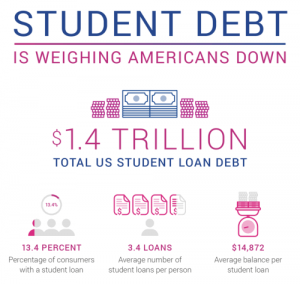(Akiit.com) The student debt crisis in our country is worsening. If nothing is done, its size threatens our nation’s future. Young people saddled with student debt often postpone adult decisions, like purchasing homes or getting married, hoping to start “real life” with a clean slate. When these folks delay buying homes, they also postpone the purchase of everything that goes with home ownership – furniture, appliances, and more. Millions boomerang home, living with their parents into their late twenties, or even longer. Some default on their loans, ruining their credit, and impeding other purchasing.
How bad is it? Student debt in our country totals almost $1.6 trillion in 2018, $521 billion more than credit card debt. More than two-thirds of all students take out student loans, with an average debt of $29,800. A total of nearly 45 million Americans have student loan debt. And if it is bad for the overall population, it’s worse for African American students, who recently graduated with $37,000 in debt, more than $7,000 more than the overall average. According to Ashley Harrington, of the Center for Responsible Lending, 85 percent of all African American graduates carried student loan debt in 2016, compared to the 2016 overall average of 68 percent. “Black students take out more loans and often take longer to pay them back”, she said. The result? A decade after college graduation, African Americans who had student loan debt owe twice as much as their white counterparts.
This is not at all surprising. African American median incomes are lower than white incomes. African American wealth is less a small fraction of white wealth. African American unemployment rates are higher than white rates, even for college graduates. On average, African Americans are stuck at the economic periphery, with every indicator showing Black folks lagging others in our economy.
And while the student loan crisis hits the Black community hard, it so profoundly affects our national economy that Democratic Presidential candidates Bernie Sanders and Elizabeth Warren are getting major traction from their plans to reduce or eliminate student loan debt. Indeed, Sanders gets more support among those in the 18-34 age group than any of his competitors (Biden gets little support from younger people, and Warren garners a healthy 25 percent from young people in recent polls), partly because he has been extraordinarily vocal in addressing student loan debt.
The presidential candidates have not been the only ones, who have expressed concern about the heavy burden of student loan debt. Congress implemented the Public Service Loan Forgiveness Program as part of the College Cost Reduction and Access Act of 2007. After paying a percentage of their income for 120 consecutive months, public servants like teachers and firefighters, and people who work for nonprofit organizations, could qualify to have the remainder of their loan forgiven. From the legislation, the first to receive loan forgiveness would get it in 2017. By March of 2019, however, fewer than one thousand people (of 55,000 that applied) were granted loan forgiveness. This is mostly attributable to sloppy administration of the program by the current Department of Education. Indeed, the current administration has proposed eliminating the forgiveness program. Congressman Robert “Bobby” Scott, the Virginia Democrat who chairs the House Education and Labor Committee, held hearings on this matter. Witnesses cited conflicting information that they received, payments that were not credited so that the loan relief that they expected has not been forthcoming.
The heavy student loan debt that Black students carry broadens an already wide wealth gap. Besides race, it also broadens the class inequities that exist in our society. Access to affordable higher education is one of the ways to narrow gaps, but the keyword is affordability. Both the federal and state governments have decreased their investments in higher education. The maximum Pell grant amount, at $6195, does not cover the cost of tuition at a four year college, not to mention the cost of attendance (tuition, room, and board).
While high student loan debt may be debilitating for the individuals who incur it, it is essential also to note that this debt has an impact on our nation’s economic futures. If we think that education is critical, then we must take steps to make it more affordable. Elizabeth Warren and Bernie Sanders get rousing cheers when they talk about forgiving student loan debt. It’s time to turn talk into action.
Columnist; Julianne Malveaux
FB Page; http://facebook.com/julianne.malveaux









Leave a Reply